My ambition is handicapped by laziness. -C. Bukowski Me gustan las personas desesperadas con mentes rotas y destinos rotos. Están llenos de sorpresas y explosiones. -C. Bukowski. I love cats. Born in the early 80's, raised in the 90's. I like Nature, Autumn, books, landscapes, cold days, cloudy Windy days, space, Science, Paleontology, Biology, Astronomy, History, Social Sciences, Drawing, spending the night watching at the stars, Rick & Morty. I'm a lazy ass.
222 posts
Latest Posts by monstrous-mind - Page 2
🍁🍂




🔭🌌🌃🍂

Saturn: image taken by the Cassini spacecraft on June 4, 2011 from a distance of 3.8 million km.
Credit: Mike Malaska
🌄🍁🍂🎃🍂🍁🍃






🍁🍂🎃🍂🍁🌬🌨






Autumn dressed up in gold, is the richest season of the soul.
🔭🌌🌃

Saturn - GREEN-BLUE-VIOLET - August 11 1981 Credit: NASA/JPL-Caltech/Kevin M. Gill
🍂🍁🍂🎃🌎









Beautiful ginkgo trees at historic Sungkyunkwan University.
🍁🍂🎃🌄

Wistfully Country on Pinterest.
🌄🌬🍁🍂🎃🍂🍁🍃💙





Japanese Autumnal Wordporn

This image shows knots of cold, dense interstellar gas where new stars are forming. These Free-floating Evaporating Gaseous Globules (frEGGs) were first seen in Hubble’s famous 1995 image of the Eagle Nebula. Because these lumps of gas are dark, they are rarely seen by telescopes. They can be observed when the newly forming stars ignite, their intense ultraviolet radiation eroding the surrounding gas away and letting the denser, more resistant frEGGs remain. These frEGGs are located in the Northern Coalsack Nebula in the direction of Cygnus.
Credit: NASA, ESA, and R. Sahai (Jet Propulsion Laboratory); Processing: Gladys Kober (NASA/Catholic University of America)
🔭🌃🌌
Cosmic Alphabet Soup: Classifying Stars

If you’ve spent much time stargazing, you may have noticed that while most stars look white, some are reddish or bluish. Their colors are more than just pretty – they tell us how hot the stars are. Studying their light in greater detail can tell us even more about what they’re like, including whether they have planets. Two women, Williamina Fleming and Annie Jump Cannon, created the system for classifying stars that we use today, and we’re building on their work to map out the universe.

By splitting starlight into spectra – detailed color patterns that often feature lots of dark lines – using a prism, astronomers can figure out a star’s temperature, how long it will burn, how massive it is, and even how big its habitable zone is. Our Sun’s spectrum looks like this:

Astronomers use spectra to categorize stars. Starting at the hottest and most massive, the star classes are O, B, A, F, G (like our Sun), K, M. Sounds like cosmic alphabet soup! But the letters aren’t just random – they largely stem from the work of two famous female astronomers.

Williamina Fleming, who worked as one of the famous “human computers” at the Harvard College Observatory starting in 1879, came up with a way to classify stars into 17 different types (categorized alphabetically A-Q) based on how strong the dark lines in their spectra were. She eventually classified more than 10,000 stars and discovered hundreds of cosmic objects!

That was back before they knew what caused the dark lines in spectra. Soon astronomers discovered that they’re linked to a star’s temperature. Using this newfound knowledge, Annie Jump Cannon – one of Fleming’s protégés – rearranged and simplified stellar classification to include just seven categories (O, B, A, F, G, K, M), ordered from highest to lowest temperature. She also classified more than 350,000 stars!

Type O stars are both the hottest and most massive in the new classification system. These giants can be a thousand times bigger than the Sun! Their lifespans are also around 1,000 times shorter than our Sun’s. They burn through their fuel so fast that they only live for around 10 million years. That’s part of the reason they only make up a tiny fraction of all the stars in the galaxy – they don’t stick around for very long.

As we move down the list from O to M, stars become progressively smaller, cooler, redder, and more common. Their habitable zones also shrink because the stars aren’t putting out as much energy. The plus side is that the tiniest stars can live for a really long time – around 100 billion years – because they burn through their fuel so slowly.

Astronomers can also learn about exoplanets – worlds that orbit other stars – by studying starlight. When a planet crosses in front of its host star, different kinds of molecules in the planet’s atmosphere absorb certain wavelengths of light.
By spreading the star’s light into a spectrum, astronomers can see which wavelengths have been absorbed to determine the exoplanet atmosphere’s chemical makeup. Our James Webb Space Telescope will use this method to try to find and study atmospheres around Earth-sized exoplanets – something that has never been done before.

Our upcoming Nancy Grace Roman Space Telescope will study the spectra from entire galaxies to build a 3D map of the cosmos. As light travels through our expanding universe, it stretches and its spectral lines shift toward longer, redder wavelengths. The longer light travels before reaching us, the redder it becomes. Roman will be able to see so far back that we could glimpse some of the first stars and galaxies that ever formed.
Learn more about how Roman will study the cosmos in our other posts:
Roman’s Family Portrait of Millions of Galaxies
New Rose-Colored Glasses for Roman
How Gravity Warps Light
Make sure to follow us on Tumblr for your regular dose of space!
🔭🌃🌌🪐🍁🍂⛄
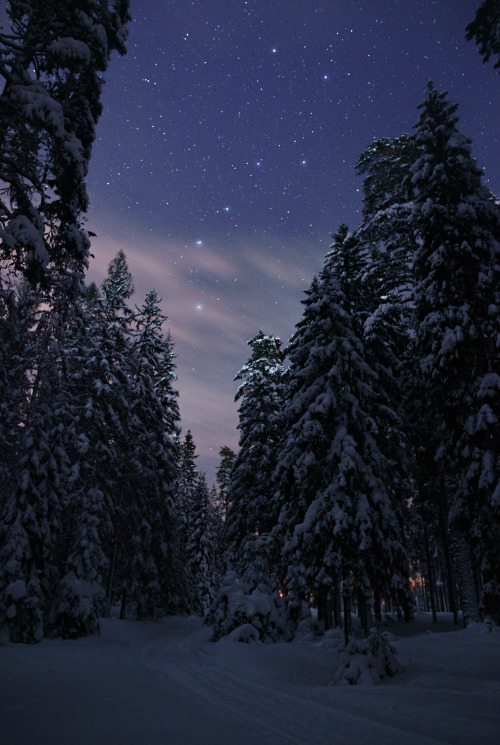
Under the big dipper
by: Mikhail Reva
🐈🐾🍁🍂🎃🍂🍁🌨🌄

🍃🍂🍁🎃
![Fall Colors In The White Mountains Of New Hampshire [OC][1600x1067] By: Bckpkrs](https://64.media.tumblr.com/ff891d0eb5e06185fb1760497cd5c5da/58a249b5dcd3e147-6d/s500x750/f45b4249f2d7683c278bac67dda3202a095e71c2.jpg)
Fall colors in the White Mountains of New Hampshire [OC][1600x1067] by: bckpkrs
🍂🍁🍃








竹の寺 地蔵院 🍁紅葉2021🍁
Jizo-in temple

This photo of Comet Leonard was taken from a remote facility in Namibia.
SpaceWeatherGallery.com/Lukas Demetz / Michael Jaeger
Black Holes Dine on Stellar Treats!

See that tiny blob of light, circled in red? Doesn’t look like much, does it? But that blob represents a feast big enough to feed a black hole around 30 million times the mass of our Sun! Scientists call these kinds of stellar meals tidal disruption events, and they’re some of the most dramatic happenings in the cosmos.

Sometimes, an unlucky star strays too close to a black hole. The black hole’s gravity pulls on the star, causing it to stretch in one direction and squeeze in another. Then the star pulls apart into a stream of gas. This is a tidal disruption event. (If you’re worried about this happening to our Sun – don’t. The nearest black hole we know about is over 1,000 light-years away. And black holes aren’t wild space vacuums. They don’t go zipping around sucking up random stars and planets. So we’re pretty safe from tidal disruption events!)

The trailing part of the stream gets flung out of the system. The rest of the gas loops back around the black hole, forming a disk. The material circling in the disk slowly drifts inward toward the black hole’s event horizon, the point at which nothing – not even light – can escape. The black hole consumes the gas and dust in its disk over many years.

Sometimes the black hole only munches on a passing star – we call this a partial tidal disruption event. The star loses some of its gas, but its own gravity pulls it back into shape before it passes the black hole again. Eventually, the black hole will have nibbled away enough material that the star can’t reform and gets destroyed.

We study tidal disruptions, both the full feasts and the partial snacks, using many kinds of telescopes. Usually, these events are spotted by ground-based telescopes like the Zwicky Transient Facility and the All-Sky Automated Survey for Supernovae network.

They alert other ground- and space-based telescopes – like our Neil Gehrels Swift Observatory (illustrated above) and the European Space Agency’s XMM-Newton – to follow up and collect more data using different wavelengths, from visible light to X-rays. Even our planet-hunting Transiting Exoplanet Survey Satellite has observed a few of these destructive wonders!
We’re also studying disruptions using multimessenger astronomy, where scientists use the information carried by light, particles, and space-time ripples to learn more about cosmic objects and occurrences.

But tidal disruptions are super rare. They only happen once every 10,000 to 100,000 years in a galaxy the size of our own Milky Way. Astronomers have only observed a few dozen events so far. By comparison, supernovae – the explosive deaths of stars – happen every 100 years or so in a galaxy like ours.
That’s why scientists make their own tidal disruptions using supercomputers, like the ones shown in the video here. Supercomputers allow researchers to build realistic models of stars. They can also include all of the physical effects they’d experience whipping ‘round a black hole, even those from Einstein’s theory of general relativity. They can alter features like how close the stars get and how massive the black holes are to see how it affects what happens to the stars. These simulations will help astronomers build better pictures of the events they observe in the night sky.
Keep up with what’s happening in the universe and how we study it by following NASA Universe on Twitter and Facebook.
Make sure to follow us on Tumblr for your regular dose of space!

Spotted: signs of a planet about 28 million light-years away 🔎 🪐
For the first time, astronomers may have detected an exoplanet candidate outside of the Milky Way galaxy. Exoplanets are defined as planets outside of our Solar System. All other known exoplanets and exoplanet candidates have been found in the Milky Way, almost all of them less than about 3,000 light-years from Earth.
This new result is based on transits, events in which the passage of a planet in front of a star blocks some of the star's light and produces a characteristic dip. Researchers used our Chandra X-ray Observatory to search for dips in the brightness of X-rays received from X-ray bright binaries in the spiral galaxy Messier 51, also called the Whirlpool Galaxy (pictured here). These luminous systems typically contain a neutron star or black hole pulling in gas from a closely orbiting companion star. They estimate the exoplanet candidate would be roughly the size of Saturn, and orbit the neutron star or black hole at about twice the distance of Saturn from the Sun.
This composite image of the Whirlpool Galaxy was made with X-ray data from Chandra and optical light from our Hubble Space Telescope.
Credit: X-ray: NASA/CXC/SAO/R. DiStefano, et al.; Optical: NASA/ESA/STScI/Grendler
Make sure to follow us on Tumblr for your regular dose of space!
🌬🍃🍁🍂🎃🍂🍁

🌃🌌🔭

Geminid Meteors over Chile
Image Credit & Copyright: Yuri Beletsky (Las Campanas Observatory, Carnegie Institution)

Images of Saturn, Tethys, and Mimas taken by Cassini on July 16 2005.
Credit: NASA/JPL-Caltech/SSI/CICLOPS/Kevin M. Gill
🔭🌃🌌🍂🍁

Saturn & Tethys - June 2 2007
Credit: NASA/JPL-Caltech/SSI/CICLOPS/Kevin M. Gill
🐈🐏🐱🌄🍂🍁
“I woolly wuv your wool”
🔭🌃🌌

Ocean on the moon Europa
Scientists' consensus is that a layer of liquid water exists beneath Europa's surface, and that heat from tidal flexing allows the subsurface ocean to remain liquid.

Europa's surface temperature averages about 110 K (−160 °C; −260 °F) at the equator and only 50 K (−220 °C; −370 °F) at the poles, keeping Europa's icy crust as hard as granite. The first hints of a subsurface ocean came from theoretical considerations of tidal heating (a consequence of Europa's slightly eccentric orbit and orbital resonance with the other Galilean moons). Galileo imaging team members argue for the existence of a subsurface ocean from analysis of Voyager and Galileo images.

The most dramatic example is "chaos terrain", a common feature on Europa's surface that some interpret as a region where the subsurface ocean has melted through the icy crust.
The thin-ice model suggests that Europa's ice shell may be only a few kilometers thick. However, most planetary scientists conclude that this model considers only those topmost layers of Europa's crust that behave elastically when affected by Jupiter's tides.

The Hubble Space Telescope acquired an image of Europa in 2012 that was interpreted to be a plume of water vapour erupting from near its south pole The image suggests the plume may be 200 km (120 mi) high, or more than 20 times the height of Mt. Everest.
Life?
So far, there is no evidence that life exists on Europa, but Europa has emerged as one of the most likely locations in the Solar System for potential habitability. Life could exist in its under-ice ocean, perhaps in an environment similar to Earth's deep-ocean hydrothermal vents. Even if Europa lacks volcanic hydrothermal activity, a 2016 NASA study found that Earth-like levels of hydrogen and oxygen could be produced through processes related to serpentinization and ice-derived oxidants, which do not directly involve volcanism.

In 2015, scientists announced that salt from a subsurface ocean may likely be coating some geological features on Europa, suggesting that the ocean is interacting with the seafloor. This may be important in determining if Europa could be habitable. The likely presence of liquid water in contact with Europa's rocky mantle has spurred calls to send a probe there.
Missions

Europa Clipper is an interplanetary mission in development by NASA comprising an orbiter. Set for a launch in October 2024, the spacecraft is being developed to study the Galilean moon Europa through a series of flybys while in orbit around Jupiter.

The Europa Lander is a proposed astrobiology mission concept by NASA to Europa, an icy moon of Jupiter. If funded and developed as a large strategic science mission, it would be launched in 2027 to complement the studies by the Europa Clipper orbiter mission and perform analyses on site. NASA's budget for fiscal year 2021 neither mandates nor allocates any funds to the mission leaving its future uncertain.
The objectives of the mission are to search for biosignatures at the subsurface ≈10 cm, to characterize the composition of non-ice near-subsurface material, and determine the proximity of liquid water and recently erupted material near the lander's location.
source

What drives auroras on Saturn? To help find out, scientists have sorted through hundreds of infrared images of Saturn taken by the Cassini spacecraft for other purposes, trying to find enough aurora images to correlate changes and make movies. Once made, some movies clearly show that Saturnian auroras can change not only with the angle of the Sun, but also as the planet rotates. Furthermore, some auroral changes appear related to waves in Saturn's magnetosphere likely caused by Saturn's moons. Pictured here, a false-colored image taken in 2007 shows Saturn in three bands of infrared light. The rings reflect relatively blue sunlight, while the planet itself glows in comparatively low energy red. A band of southern aurora in visible in green. In has recently been found that auroras heat Saturn's upper atmosphere. Understanding Saturn's auroras is a path toward a better understanding of Earth's auroras.
Image Credit: NASA, Cassini, VIMS Team, U. Arizona, U. Leicester, JPL, ASI
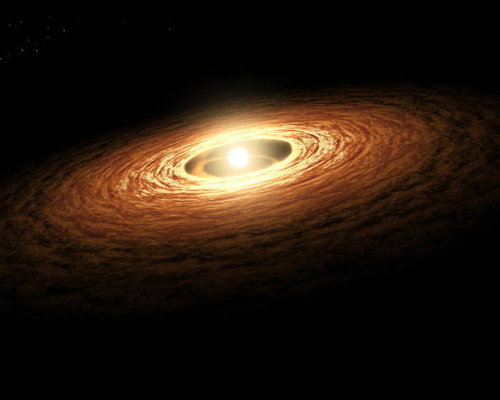
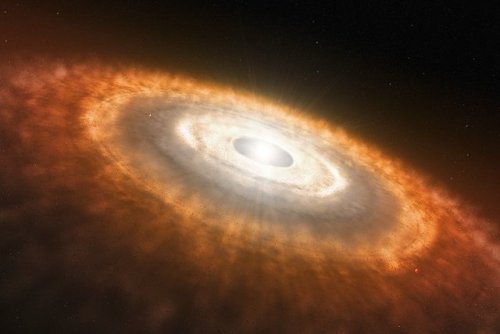
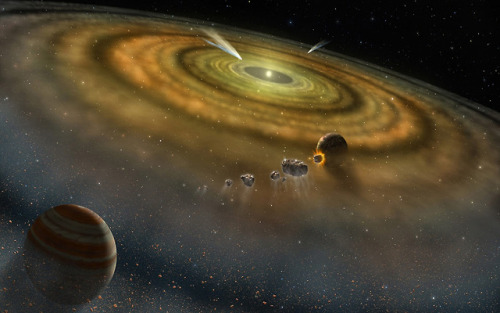
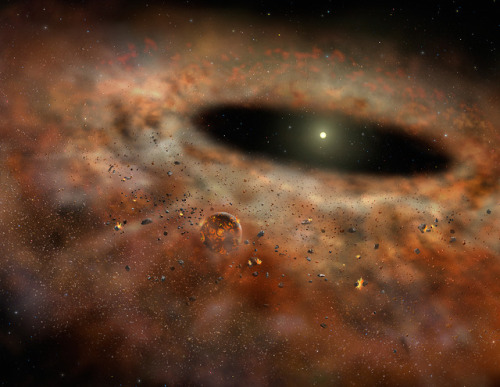
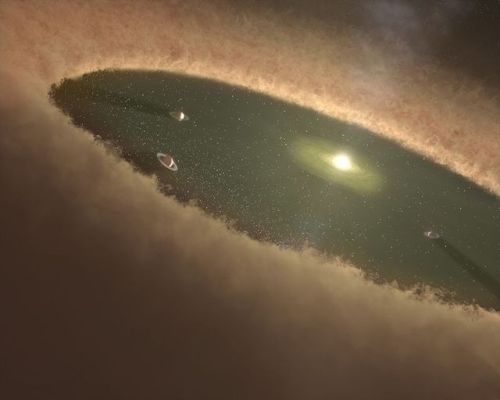
A protoplanetary disk is a rotating circumstellar disk of dense gas and dust surrounding a young newly formed star, a T Tauri star, or Herbig Ae/Be star. The protoplanetary disk may also be considered an accretion disk for the star itself, because gases or other material may be falling from the inner edge of the disk onto the surface of the star. This process should not be confused with the accretion process thought to build up the planets themselves. Externally illuminated photo-evaporating protoplanetary disks are called proplyds.
The nebular hypothesis of solar system formation describes how protoplanetary disks are thought to evolve into planetary systems. Electrostatic and gravitational interactions may cause the dust and ice grains in the disk to accrete into planetesimals. This process competes against the stellar wind, which drives the gas out of the system, and gravity (accretion), which pulls material into the central T Tauri star.
source
Image credit: NASA/JPL, ESO
🔭🌃🌌

M44, the beehive Cluster in Cancer constellation
Credit: Alan Dyer




Ginger Snaps Directed by John Fawcett (2000)
🔭🌃🌌
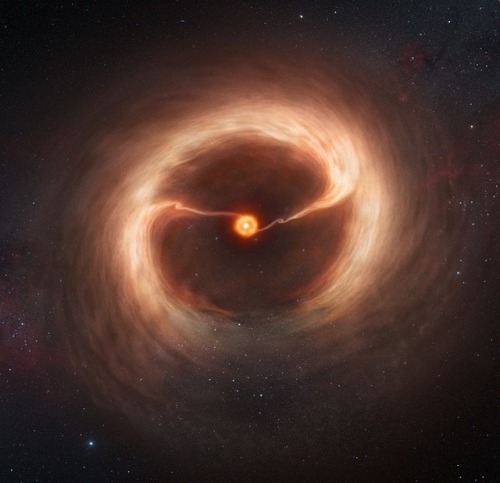
This artist’s impression shows the disc of gas and cosmic dust around the young star HD 142527. Astronomers using the Atacama Large Millimeter/submillimeter Array (ALMA) telescope have seen vast streams of gas flowing across the gap in the disc. These are the first direct observations of these streams, which are expected to be created by giant planets guzzling gas as they grow, and which are a key stage in the birth of giant planets.
Credit: ESO / Atacama Large Millimeter/submillimeter Array
🔭🌃🌌

Kepler-186f is the first Earth-sized planet ever found that also orbits in its star’s habitable zone. Although its size and orbit are known, its mass and composition are not - however, existing models suggest that it could have a rocky terrain and an atmosphere, making it potentially the most Earth-like planet discovered so far.










Was Earth Born With Life On It?
“By finding graphite deposits in zircons that are 4.1 billion years old, graphite deposits that show this carbon-12 enhancement, we now have evidence that life on Earth goes back at least 90% of Earth’s history, and possibly even longer! After all, finding the remnants of organic matter in a certain location means the organic matter is at least as old as the location it’s buried in, but it could still be even older. This is so early that it might make you think that perhaps this life didn’t originate here on Earth, but that Earth was born with life. And this could really, truly be the case.”
How old is life on Earth? If all you had to go on was the fossil record, you’d run into severe trouble once you went back more than one or two billion years, as all your rock would have metamorphosed, making examination and identification of fossils impossible. But recently, we’ve discovered another method: to measure the isotopic content of carbon deposits in ancient rock formations. The carbon-12 to carbon-13 ratio is a surefire signature of life, and tells us that life on Earth goes back at least 4.1 billion years: 90% of the age of our planet. Could this be the hint we’ve needed to conclude that life on Earth actually predates the Earth itself? It’s not quite certain, but the beauty of science is we can always test it and find out! Here’s how.